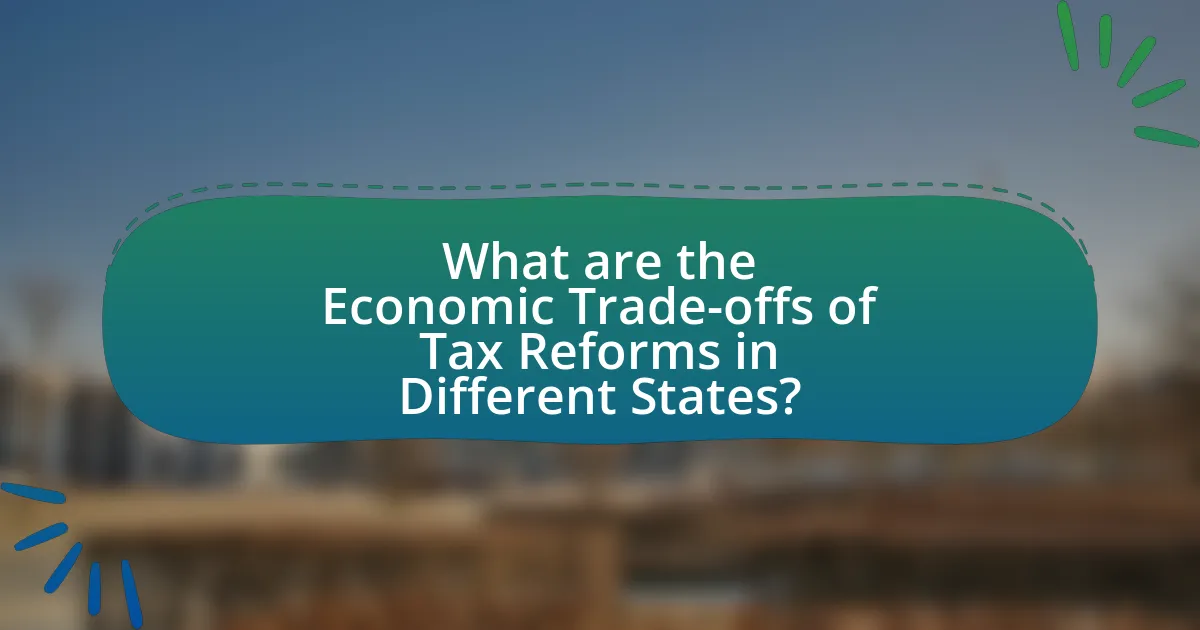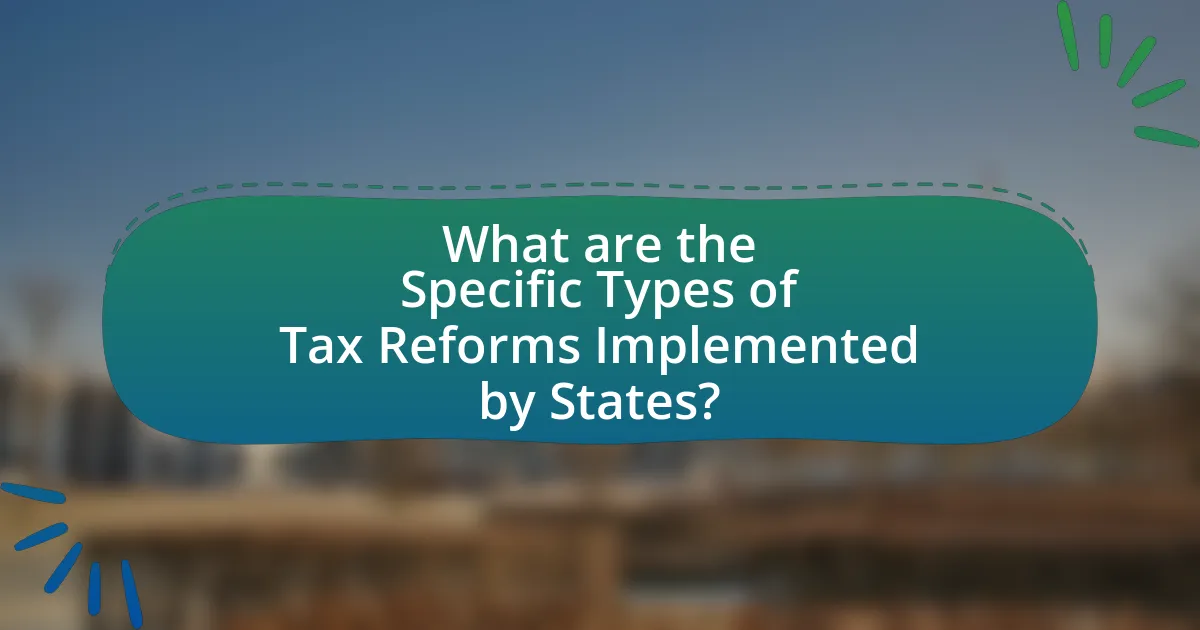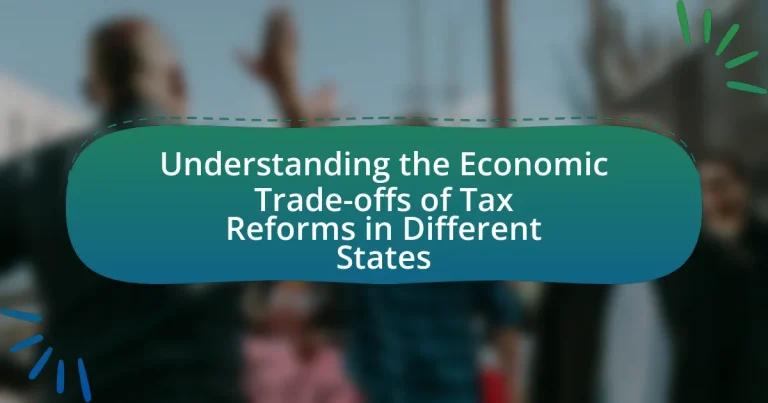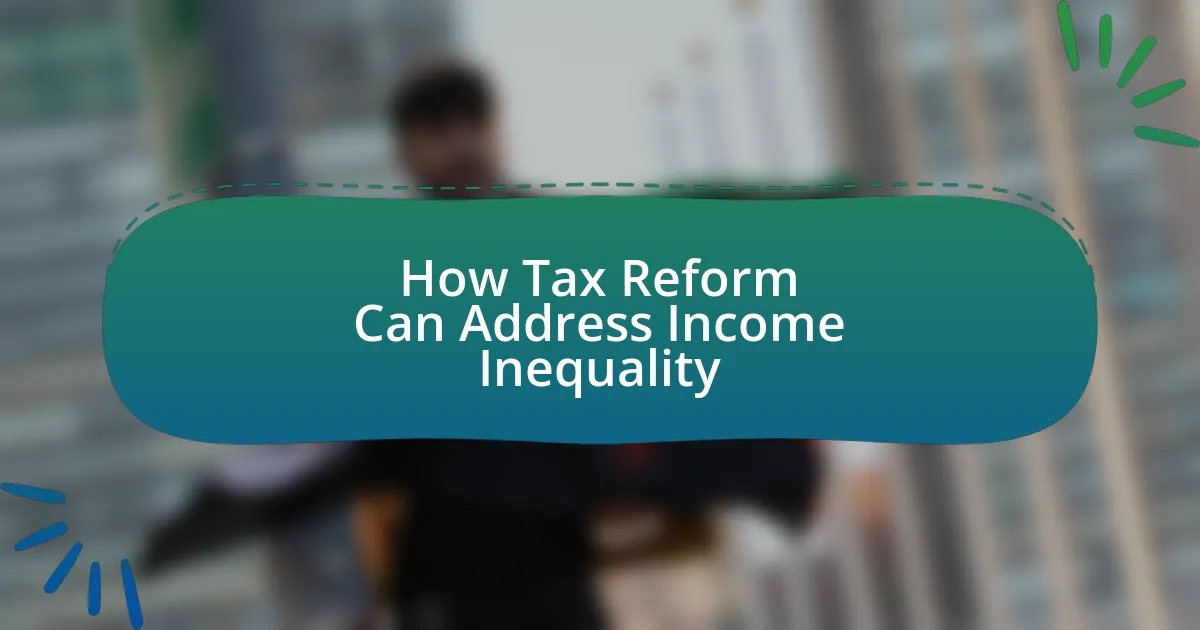The article examines the economic trade-offs associated with tax reforms across different states, highlighting how variations in tax policies can influence revenue generation, economic growth, and equity impacts. It discusses the short-term and long-term effects of tax reforms on state economies, the factors contributing to their effectiveness, and the demographic differences that shape reform outcomes. Additionally, the article addresses the political dynamics, public opinion, and specific types of tax reforms implemented by states, while also exploring the potential risks and challenges that arise during the reform process. Through this analysis, the article aims to provide a comprehensive understanding of how tax reforms can affect public services, infrastructure investment, and overall economic stability.

What are the Economic Trade-offs of Tax Reforms in Different States?
Economic trade-offs of tax reforms in different states include variations in revenue generation, economic growth, and equity impacts. For instance, states that lower income taxes may stimulate economic activity by attracting businesses and individuals, as seen in Texas, which has no state income tax and has experienced significant job growth. Conversely, states that increase taxes on higher incomes, like California, may generate more revenue for public services but could deter high-income earners and businesses, potentially slowing economic growth. Additionally, tax reforms can lead to disparities in wealth distribution; states with progressive tax systems aim for equity but may face backlash from higher earners. These trade-offs illustrate the complex balance states must navigate when implementing tax reforms.
How do tax reforms impact state economies?
Tax reforms significantly impact state economies by altering revenue generation and influencing economic behavior. For instance, a reduction in income tax rates can stimulate consumer spending and attract businesses, leading to job creation and economic growth. Conversely, increasing taxes may deter investment and reduce disposable income, potentially slowing economic activity. Historical data from states like Kansas, which implemented significant tax cuts in 2012, showed initial growth but later faced budget shortfalls, illustrating the complex trade-offs involved. Additionally, research by the National Bureau of Economic Research indicates that tax policy changes can lead to shifts in migration patterns, as individuals and businesses relocate to states with more favorable tax environments.
What are the short-term effects of tax reforms on state revenue?
The short-term effects of tax reforms on state revenue typically include fluctuations in revenue levels, often resulting in an initial decrease in collections. When tax reforms are implemented, such as tax cuts or changes in tax structures, states may experience a temporary decline in revenue as businesses and individuals adjust to the new tax environment. For instance, a study by the Institute on Taxation and Economic Policy found that states that enacted significant tax cuts often saw a drop in revenue in the first year following the reform. This occurs because the immediate impact of reduced tax rates can lead to lower revenue intake before any potential economic growth or increased compliance materializes.
How do tax reforms influence long-term economic growth?
Tax reforms influence long-term economic growth by altering incentives for investment, consumption, and labor supply. For instance, lower corporate tax rates can encourage businesses to invest more in capital and innovation, leading to increased productivity. A study by the National Bureau of Economic Research found that a 1% reduction in corporate tax rates can lead to a 0.5% increase in GDP over the long term. Additionally, tax reforms that simplify the tax code can reduce compliance costs, further stimulating economic activity. Overall, effective tax reforms can create a more favorable economic environment, promoting sustained growth.
What factors contribute to the effectiveness of tax reforms?
The effectiveness of tax reforms is primarily influenced by the clarity of the reform objectives, the design of the tax system, and the political and economic context in which the reforms are implemented. Clear objectives ensure that reforms target specific issues, such as increasing revenue or promoting equity. A well-designed tax system, which includes features like broad tax bases and low rates, enhances compliance and minimizes avoidance. Additionally, the political environment, including stakeholder support and public perception, significantly affects the implementation and sustainability of tax reforms. For instance, the 2017 Tax Cuts and Jobs Act in the United States aimed to stimulate economic growth through corporate tax reductions, demonstrating how design and context can shape reform outcomes.
How do demographic differences across states affect tax reform outcomes?
Demographic differences across states significantly influence tax reform outcomes by shaping the political priorities and economic needs of each state. For instance, states with higher populations of low-income residents may advocate for tax reforms that increase progressive taxation to fund social services, while states with a larger proportion of affluent residents might favor tax cuts to stimulate investment. According to the U.S. Census Bureau, states like California and New York, which have diverse and densely populated urban areas, often push for reforms that address income inequality, whereas states like Wyoming and North Dakota, with smaller populations and different economic structures, may prioritize tax policies that encourage business growth. This divergence in demographic composition leads to varied tax reform proposals and outcomes, reflecting the unique economic and social landscapes of each state.
What role do existing economic conditions play in tax reform success?
Existing economic conditions significantly influence the success of tax reform by determining the political feasibility and public acceptance of proposed changes. For instance, during periods of economic growth, there is often greater public support for tax reforms aimed at reducing rates or broadening the tax base, as seen in the 2017 Tax Cuts and Jobs Act in the United States, which capitalized on a strong economy to implement substantial tax cuts. Conversely, in times of economic downturn, such as the 2008 financial crisis, proposed tax reforms may face resistance due to concerns over budget deficits and the potential impact on public services. Historical data shows that tax reforms are more likely to succeed when aligned with favorable economic indicators, such as low unemployment rates and rising GDP, which create a conducive environment for change.
Why do states pursue different tax reform strategies?
States pursue different tax reform strategies primarily due to varying economic conditions, political ideologies, and demographic factors. Economic conditions, such as revenue needs and growth rates, influence states to adopt reforms that align with their fiscal health; for instance, states with budget deficits may prioritize tax increases or broaden tax bases. Political ideologies shape tax policies, where conservative states may favor lower taxes and reduced government spending, while liberal states might advocate for progressive taxation to fund social programs. Additionally, demographic factors, including population size and diversity, affect tax reform strategies; states with aging populations may focus on property taxes and retirement income taxation, while those with younger populations might emphasize sales taxes and income taxes. These diverse influences lead to a spectrum of tax reform approaches across states, reflecting their unique economic trade-offs and priorities.
What political factors influence tax reform decisions in states?
Political factors that influence tax reform decisions in states include party control, public opinion, interest group lobbying, and electoral considerations. Party control significantly affects tax policy direction; for instance, states with Democratic leadership often pursue progressive tax reforms, while Republican-led states may favor tax cuts. Public opinion shapes reform initiatives, as elected officials respond to constituents’ preferences regarding taxation. Interest groups, such as business associations or labor unions, actively lobby for specific tax policies that align with their interests, impacting legislative outcomes. Additionally, electoral considerations drive politicians to propose tax reforms that resonate with voters, especially during election cycles, as seen in various state-level tax initiatives.
How do public opinions shape tax reform initiatives?
Public opinions significantly shape tax reform initiatives by influencing policymakers’ decisions and legislative agendas. When a majority of the public expresses support or opposition to specific tax policies, elected officials often respond to these sentiments to secure votes and maintain public approval. For instance, surveys conducted by organizations like the Pew Research Center show that public attitudes toward taxation can directly impact the likelihood of reforms being proposed or enacted. In states where citizens prioritize tax relief, lawmakers may introduce initiatives aimed at reducing tax burdens, while in regions where there is a demand for increased public services, tax increases may be more readily accepted. This dynamic illustrates how public sentiment acts as a barometer for political action regarding tax reform.

What are the Specific Types of Tax Reforms Implemented by States?
States implement various specific types of tax reforms, including income tax changes, sales tax adjustments, property tax modifications, and corporate tax reforms. For instance, some states have reduced income tax rates to stimulate economic growth, while others have shifted from progressive to flat tax systems to simplify tax structures. Additionally, states may increase or decrease sales tax rates to manage revenue needs, and property tax reforms often involve reassessments or caps on increases to alleviate burdens on homeowners. Corporate tax reforms can include incentives for businesses to relocate or expand, impacting overall economic activity. These reforms are often driven by the need to balance budgets, attract investment, and respond to public demand for equitable taxation.
What are the common types of tax reforms adopted by states?
Common types of tax reforms adopted by states include income tax restructuring, sales tax adjustments, property tax modifications, and corporate tax changes. Income tax restructuring often involves lowering rates or shifting to a flat tax system, as seen in states like Massachusetts and North Carolina. Sales tax adjustments may include broadening the tax base or increasing rates, which has been implemented in states such as California. Property tax modifications often focus on reassessment practices or caps on increases, with states like Florida adopting measures to limit property tax growth. Corporate tax changes can involve rate reductions or the introduction of incentives to attract businesses, as evidenced by reforms in Texas. These reforms aim to enhance economic competitiveness, improve revenue stability, and address equity concerns within the tax system.
How do income tax reforms differ from sales tax reforms?
Income tax reforms differ from sales tax reforms primarily in their structure and impact on taxpayers. Income tax reforms focus on the taxation of individual or corporate earnings, often adjusting rates or brackets to influence income distribution and economic behavior. For instance, progressive income tax systems impose higher rates on higher income levels, aiming to reduce inequality. In contrast, sales tax reforms target consumption by taxing goods and services at the point of sale, which can disproportionately affect lower-income individuals who spend a larger portion of their income on taxable items.
Evidence of these differences can be seen in various states; for example, California’s progressive income tax system contrasts with Texas’s reliance on sales tax, highlighting how each approach affects revenue generation and economic equity.
What are the implications of property tax reforms?
Property tax reforms can lead to significant economic implications, including changes in revenue generation for local governments and shifts in housing market dynamics. For instance, a reduction in property tax rates may stimulate real estate investment and increase property values, as evidenced by studies showing that lower taxes can enhance affordability and attract new residents. Conversely, increasing property taxes can generate additional revenue for public services but may also deter investment and lead to housing market stagnation, as seen in states where tax hikes have resulted in decreased home sales. These reforms can also disproportionately affect low-income households, as they may face higher relative tax burdens, impacting their economic stability and access to housing.
How do states balance tax reforms with public service funding?
States balance tax reforms with public service funding by adjusting tax rates and structures while ensuring adequate revenue for essential services. For instance, when states implement tax cuts, they often analyze the potential impact on revenue and may offset losses by broadening the tax base or increasing certain taxes, such as sales or property taxes. According to the National Conference of State Legislatures, states frequently conduct fiscal impact analyses to project how tax reforms will affect public service funding, ensuring that critical areas like education and healthcare remain adequately financed. This strategic approach allows states to maintain a balance between fostering economic growth through tax incentives and fulfilling their obligations to provide necessary public services.
What strategies do states use to mitigate funding shortfalls after tax reforms?
States employ several strategies to mitigate funding shortfalls after tax reforms, including diversifying revenue sources, implementing spending cuts, and enhancing efficiency in public services. Diversifying revenue sources allows states to reduce reliance on a single tax type, such as income or sales tax, thereby stabilizing funding. For instance, states may increase fees for services or expand tax bases to include previously untaxed sectors. Implementing spending cuts helps states align expenditures with reduced revenue, often targeting non-essential programs while preserving critical services. Additionally, enhancing efficiency in public services can lead to cost savings, allowing states to maintain service levels despite lower funding. According to the National Association of State Budget Officers, states have increasingly turned to these strategies in response to fiscal pressures following tax reforms, demonstrating their effectiveness in managing budgetary constraints.
How do tax reforms affect public services and infrastructure investment?
Tax reforms significantly impact public services and infrastructure investment by altering government revenue streams. When tax rates are reduced, governments may experience a decrease in available funds for essential services such as education, healthcare, and transportation. For instance, a study by the Center on Budget and Policy Priorities found that states that implemented significant tax cuts often faced budget shortfalls, leading to cuts in public services and infrastructure projects. Conversely, tax increases can provide additional revenue, enabling governments to invest more in public services and infrastructure, as evidenced by states that raised taxes to fund large-scale infrastructure initiatives, resulting in improved public facilities and services.
What lessons can be learned from successful tax reforms in various states?
Successful tax reforms in various states demonstrate that targeted tax incentives can stimulate economic growth and attract businesses. For instance, North Carolina’s corporate tax rate reduction from 6.9% to 3% between 2013 and 2019 led to significant job creation and increased investment, with the state experiencing a 20% growth in private sector jobs during that period. Additionally, successful reforms often involve stakeholder engagement, as seen in Massachusetts, where collaboration with businesses and community leaders helped shape a more effective tax structure. These examples illustrate that well-planned tax reforms can enhance competitiveness and drive economic development while ensuring that the needs of various stakeholders are considered.
What best practices have emerged from states that successfully implemented tax reforms?
States that successfully implemented tax reforms have established best practices such as comprehensive stakeholder engagement, data-driven decision-making, and phased implementation. Comprehensive stakeholder engagement ensures that diverse perspectives are considered, leading to broader support and smoother transitions; for example, states like Minnesota involved businesses and community groups in their reform discussions. Data-driven decision-making allows states to analyze the potential impacts of tax changes, as seen in Massachusetts, which utilized economic modeling to predict outcomes before enacting reforms. Phased implementation, practiced by states like North Carolina, helps to mitigate risks by allowing gradual adjustments and assessments of the reforms’ effects over time. These practices have been validated by various studies showing improved economic performance and public satisfaction in states that adopted them.
How can states adapt successful tax reform strategies to their unique contexts?
States can adapt successful tax reform strategies to their unique contexts by conducting thorough assessments of their economic conditions, demographic profiles, and fiscal needs. For instance, states like Massachusetts have tailored their tax policies by analyzing local economic data and public sentiment, which led to the implementation of a graduated income tax that reflects the income distribution of its residents. This approach is supported by research from the Institute on Taxation and Economic Policy, which highlights that states that customize tax reforms based on specific local factors tend to achieve better economic outcomes and public acceptance. By leveraging data-driven insights and engaging with stakeholders, states can effectively modify successful tax strategies to align with their distinct circumstances.

What are the Potential Risks and Challenges of Tax Reforms?
The potential risks and challenges of tax reforms include economic instability, revenue shortfalls, and public opposition. Economic instability can arise from sudden changes in tax policy that disrupt business planning and investment, leading to decreased economic growth. Revenue shortfalls may occur if tax cuts do not generate anticipated economic activity, as evidenced by the 2012 tax reform in Kansas, which resulted in significant budget deficits. Public opposition can stem from perceived inequities in tax burdens, as seen in various states where reforms disproportionately affected lower-income populations, leading to protests and political backlash. These factors highlight the complexities and potential negative outcomes associated with implementing tax reforms.
What are the common risks associated with tax reforms?
Common risks associated with tax reforms include revenue loss, economic instability, and increased inequality. Revenue loss can occur when tax cuts lead to a decrease in government income, potentially resulting in budget deficits; for example, the 2017 Tax Cuts and Jobs Act in the United States projected a $1.5 trillion reduction in federal revenue over ten years. Economic instability may arise from abrupt changes in tax policy that disrupt business planning and investment, as seen in various states that have experienced volatility following tax reform implementation. Additionally, tax reforms can exacerbate inequality if they disproportionately benefit higher-income individuals, which has been documented in studies showing that tax cuts often favor wealthier taxpayers over lower-income groups.
How can tax reforms lead to unintended economic consequences?
Tax reforms can lead to unintended economic consequences by altering incentives for businesses and individuals, which can result in unexpected shifts in economic behavior. For instance, a reduction in corporate tax rates may encourage companies to invest more domestically, but it can also lead to increased income inequality if the benefits are not distributed evenly. Historical data from the 2017 Tax Cuts and Jobs Act in the United States shows that while corporate investments increased, wage growth for lower-income workers did not keep pace, highlighting the potential for widening economic disparities. Additionally, tax reforms can inadvertently create loopholes or encourage tax avoidance strategies, further complicating the intended outcomes of the reforms.
What challenges do states face in implementing tax reforms effectively?
States face several challenges in implementing tax reforms effectively, including political resistance, administrative capacity, and public acceptance. Political resistance often arises from vested interests and lobbying groups that oppose changes to the tax system, making it difficult to achieve consensus on reforms. Administrative capacity is another significant challenge, as many states may lack the necessary resources or expertise to design and implement complex tax reforms efficiently. Additionally, public acceptance is crucial; if citizens do not understand or support the reforms, they may resist compliance, undermining the intended benefits. For instance, a study by the National Conference of State Legislatures highlights that states with strong public engagement strategies tend to have more successful tax reform outcomes, demonstrating the importance of addressing these challenges comprehensively.
How do states manage public backlash against tax reforms?
States manage public backlash against tax reforms by implementing strategic communication, engaging in public consultations, and offering phased implementation of changes. For instance, effective communication involves clearly explaining the rationale behind tax reforms, which can help mitigate misunderstandings and resistance. Public consultations allow citizens to voice concerns and provide input, fostering a sense of involvement and ownership in the reform process. Additionally, phased implementation can ease the transition, giving the public time to adjust and reducing immediate negative impacts. Evidence from various states shows that these approaches can lead to higher acceptance rates of tax reforms, as seen in California’s gradual rollout of sales tax increases, which faced less opposition due to prior public engagement and clear communication.
What communication strategies can help mitigate opposition to tax reforms?
Effective communication strategies to mitigate opposition to tax reforms include transparent messaging, stakeholder engagement, and the use of data-driven narratives. Transparent messaging ensures that the rationale behind tax reforms is clearly articulated, helping to build trust and reduce misinformation. Engaging stakeholders, such as community leaders and business representatives, fosters a sense of inclusion and allows for addressing specific concerns directly. Utilizing data-driven narratives, supported by empirical evidence, can effectively illustrate the benefits of tax reforms, such as improved public services or economic growth, thereby countering negative perceptions. For instance, studies have shown that clear communication about the positive impacts of tax reforms on local economies can lead to greater public acceptance.
How can states involve stakeholders in the tax reform process?
States can involve stakeholders in the tax reform process by establishing inclusive advisory committees that represent diverse interests, such as businesses, non-profits, and community organizations. These committees facilitate dialogue and gather input on proposed tax changes, ensuring that various perspectives are considered. For instance, the state of California has utilized stakeholder engagement through public forums and surveys to assess the impact of tax reforms on different communities, which has led to more equitable policy outcomes. Engaging stakeholders not only enhances transparency but also fosters trust in the reform process, ultimately leading to more effective tax policies.
What practical steps can states take to ensure successful tax reform implementation?
States can ensure successful tax reform implementation by conducting comprehensive stakeholder consultations. Engaging with businesses, taxpayers, and community organizations allows states to gather diverse perspectives and identify potential challenges. For instance, a study by the National Conference of State Legislatures found that states that involved stakeholders early in the reform process experienced smoother transitions and higher compliance rates. Additionally, states should establish clear communication strategies to inform the public about the changes and their benefits, which can enhance public trust and acceptance. Implementing pilot programs can also help states test reforms on a smaller scale before full implementation, allowing for adjustments based on real-world feedback.
What role does data analysis play in shaping effective tax reforms?
Data analysis plays a crucial role in shaping effective tax reforms by providing empirical evidence that informs policy decisions. Through the examination of economic data, tax revenue trends, and demographic information, policymakers can identify inefficiencies and inequities in the current tax system. For instance, studies have shown that states utilizing data analytics to assess the impact of tax policies on different income groups can better tailor reforms to promote fairness and economic growth. A report by the Institute on Taxation and Economic Policy highlights that states that analyze tax data can achieve more equitable tax structures, leading to improved public services and economic stability.
How can states monitor and evaluate the impact of tax reforms post-implementation?
States can monitor and evaluate the impact of tax reforms post-implementation by utilizing a combination of data analysis, stakeholder feedback, and economic indicators. Data analysis involves collecting and examining tax revenue data, compliance rates, and economic performance metrics before and after the reform to assess changes. Stakeholder feedback, including surveys from businesses and taxpayers, provides qualitative insights into the reform’s effects on economic behavior. Economic indicators such as employment rates, investment levels, and GDP growth serve as benchmarks to measure the broader economic impact of the tax changes. For instance, a study by the National Bureau of Economic Research found that states that implemented tax reforms saw varied impacts on job creation and business investment, highlighting the importance of comprehensive evaluation methods.




